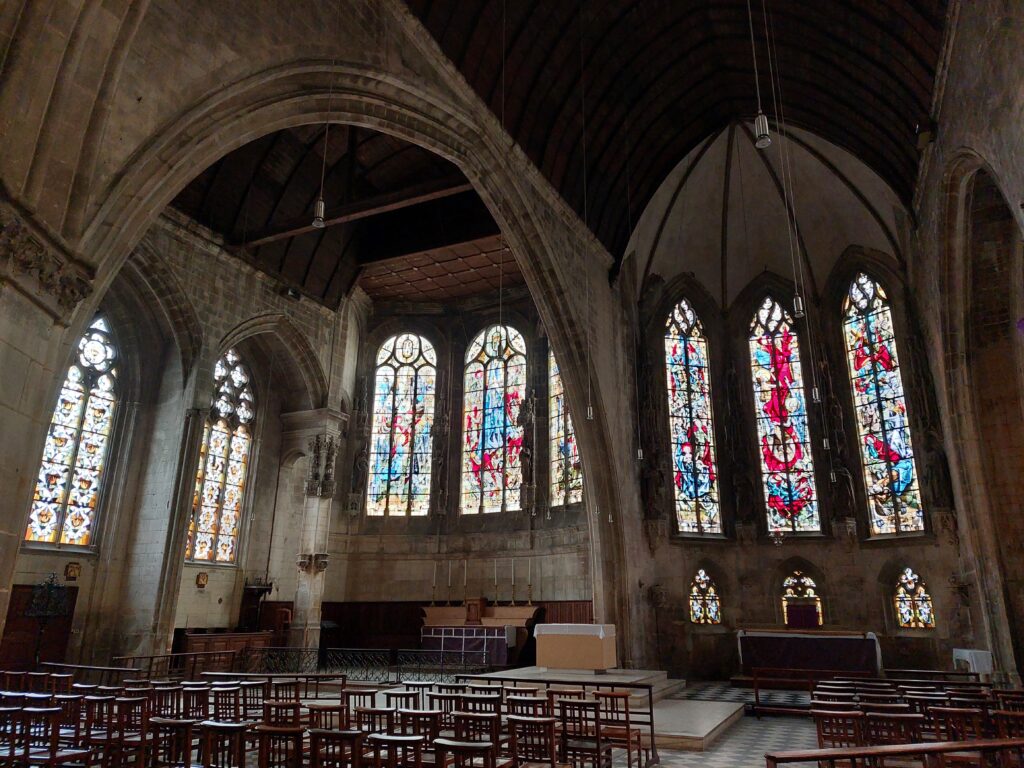Normandy is named after the Vikings (Danish and Norwegian). The Norwegian Viking Gange-Rolv was according to tradition appointed Duke Rollo of Normandy in 911, to end the Norse looting. A descendant of Rollo, Wilhelm the Conqueror, started the construction of a large castle in the city of Caen in 1060. The city experienced an economic rise based on Wilhelm’s invasion of England in 1066. The castle is still large in extent, but not so high anymore, partly due to the bombings during World War II.

We spent the Easter holiday 2022 in Caen to visit our youngest daughter, Une, who is studying there. Could there be swimming opportunities in Caen? The town is about 20 km from shore, but the river Orne is navigable all the way up, so it was worth a try. Wearing French bérets, we went to the old port – La Quai – but no, that water was too unappetizing, even for bathoholics like us. But the water photo turned out to be quite nice!

Other possible activities in Caen are church visits – there are several beautiful churches here, in a mixed Romanesque-Gothic style. And if the congregation grows out of the church, just build a new church nave in parallel with the old one, in a new and different style.

Anyway – what to do in Caen is to memorise the World War II. Many of the churches in Normandy, for example, lack a few floors, if you look closely. It became too strenuous to rebuild them to their original height after the war, so they put a roof over the lower floor instead and let it be.
And if you are (by chance) looking for a food tour, you will find excursions out of Caen with World War II as the theme. Caen itself has basically very few excursions for itself. So then you just have to go into the world of war. With the war in Ukraine simultaneously unfolding in the theater of reality, this became rather gloomy. A bus ride out of the city center you can find the Mémorial de Caen, which covers most aspects of World War II.

The center of Caen was bombed several times during the war, but the Allied bombing during Operation Neptune (D-day) was probably the worst.

With World War II as a backdrop, however, there are up to several bathing opportunities in Normandy, namely the D-Day beaches of Juno, Gold, Sword, Omaha and Utah, where the Allies carried out the largest landing operation in world history on June 6, 1944. In France, this is not just a memorial day of the losses, it’s about liberation from Nazism, and this is a real celebration.

During the D-Day festivities, the atmosphere is rather tense at the beaches, with many tourists, especially Americans, who are there to remember the fallen soldiers. At the beginning of June we would not really recommend these as bathing spots, but the rest of the year it is fine.

Omaha Beach is 8 miles long, with the finest golden sand. It was here that the landing forces experienced the greatest losses. In the course of one day, about 1,000 American soldiers died here, most of them during the morning hours, and they were on the verge of ending this landing. The first 20 minutes of the movie ‘Saving Private Ryan’ describe these scenes as well (horribly) as can be done.

We concluded that ‘yes’ we can have a bathe here. But be careful! We saw a sign warning of strong currents, so do not swim too far out!

And yes, this was a great bath. Fresh and nice water, big and fun waves on the way out. A bath on Omaha Beach is just right – when there is no D-Day celebration!
